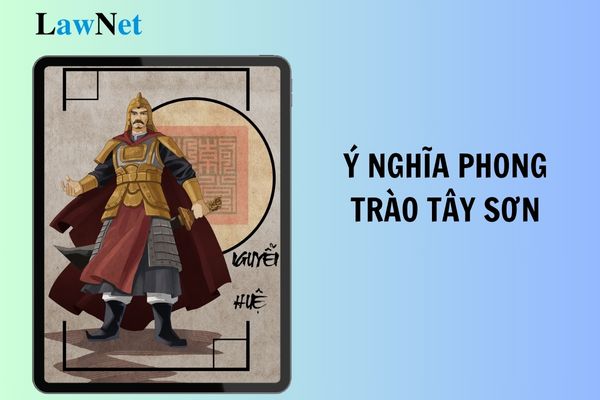What are the guidelines for analysis of the causes of Victory and the significance of the Tay Son Movement? What are the standards for 7th-grade History and Geography teachers in Vietnam?
What are the guidelines for analysis of the causes of Victory and the significance of the Tay Son Movement?
The Tay Son Movement was a peasant uprising in the late 18th century in Vietnam, led by the three brothers Nguyen Nhac, Nguyen Hue, and Nguyen Lu. The movement aimed not only to resist the domination of corrupt feudal powers but also to play an essential role in unifying the country, resisting foreign invasions, and establishing an independent state.
Below is an analysis of the causes of victory and the significance of the Tay Son Movement:
Causes of the Victory of the Tay Son Movement:
- The patriotic spirit and consensus of the military and civilians:
+ The Tay Son Movement received immense support from the people, especially from the oppressed peasant class.
+ The spirit of solidarity, enduring fighting spirit, and deep patriotism created a tremendous strength to combat both internal and external enemies.
- The outstanding leadership talent of Quang Trung - Nguyen Hue: With masterful strategic skills and excellent military command, Quang Trung always proposed flexible and creative strategies and tactics suited to the actual situation. For example, the swift march from Phu Xuan to the North to defeat the Qing army in just five days.
- The effective leadership of the Tay Son insurgent command: Not only Quang Trung, but also Nguyen Nhac and Nguyen Lu played crucial roles in mobilizing forces, organizing the movement, and laying the foundations for the military and political development of the Tay Son.
- The weakness of opposing forces:
+ The Nguyen - Trinh feudal government was severely weakened, fraught with internal conflicts, and had lost public support.
+ The Siamese and Qing armies, though powerful, were complacent, unfamiliar with the terrain, and caught off guard by the tactics of the Tay Son army.
Historical Significance of the Tay Son Movement:
- Unification of the country:
+ The Tay Son Movement overthrew the Trinh - Nguyen feudal governments, eliminating the division of the country that lasted hundreds of years.
+ This was an important turning point, laying the groundwork for restoring and consolidating national unity, paving the way for subsequent development phases.
- Protection of national independence: The victories over the Siamese at Rach Gam - Xoai Mut and the Qing in the Ngoc Hoi - Dong Da campaign not only safeguarded territorial sovereignty but also affirmed the position of the Vietnamese nation against foreign forces.
- Assertion of self-reliance and patriotism:
+ The Tay Son Movement is a symbol of patriotism, the desire for independence, and the will for self-reliance of the Vietnamese nation.
+ It also serves as a lesson in solidarity and trust in brilliant leadership to overcome all difficulties and challenges.
- Historical stature: The Tay Son Movement is significant not only in Vietnamese history but also as an important event in Southeast Asian history, as it repelled interventions by foreign powers in the region.
Note: The information is for reference only!

What are the guidelines for analysis of the causes of Victory and the significance of the Tay Son Movement? What are the standards for 7th-grade History and Geography teachers in Vietnam? (Image from the Internet)
What are the standards for 7th-grade History and Geography teachers in Vietnam?
According to the provisions of Clause 5, Article 10 of Circular 03/2021/TT-BGDDT, amended by Clause 10, Article 3 of Circular 08/2023/TT-BGDDT:
Applicable Provisions
...
5. Some cases of teachers currently teaching who meet the standards for the qualifications for lower secondary school teachers include:
a) Teachers assigned to teach History and Geography must have a bachelor's degree or higher in pedagogy training related to History or Geography or a bachelor's degree or higher in a major suitable for History or Geography. If holding a bachelor's degree in a suitable major, they must have a pedagogical certificate for lower secondary school teachers according to the curriculum issued by the Minister of Education and Training;
b) Teachers assigned to teach Natural Sciences must have a bachelor's degree or higher in pedagogy training related to Natural Sciences, Physics, Chemistry, or Biology, or a bachelor's degree in a major suitable for Natural Sciences, Physics, Chemistry, or Biology. If holding a bachelor's degree in a suitable major, they must have a pedagogical certificate for lower secondary school teachers according to the curriculum issued by the Minister of Education and Training;
...
Thus, 7th-grade History and Geography teachers in Vietnam must have a bachelor's degree or higher in pedagogy training related to History or Geography or a bachelor's degree in a major suitable for History or Geography.
If holding a bachelor's degree in a suitable major, they must have a pedagogical certificate for lower secondary school teachers according to the curriculum issued by the Minister of Education and Training.
What are the professional ethics standards for 7th-grade History and Geography teachers in Vietnam?
Under Article 2a of Circular 03/2021/TT-BGDDT, supplemented by Clause 1, Article 3 of Circular 08/2023/TT-BGDDT, the professional ethics standards for 7th-grade History and Geography teachers in Vietnam are as follows:
- Adhere to the guidelines and policies of the Communist Party of Vietnam, state laws, and regulations of the education sector and localities on secondary education.
- Regularly cultivate morality, uphold the spirit of responsibility, and maintain the integrity, honor, and reputation of the teaching profession; be a role model for students.
- Love, treat fairly, and respect students; protect their legitimate rights and interests; show solidarity and assist colleagues.
- Strictly comply with the general responsibilities and obligations of public employees and the regulations of the Ministry of Education and Training regarding teacher ethics.

